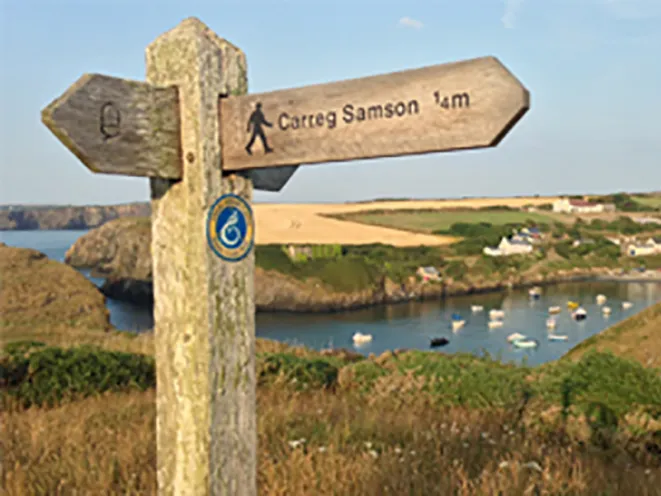Luned Emyr a’r hanesydd celf Peter Lord sydd ar drywydd y gweithiau celf niferus a ysbrydolwyd gan un o’r ffigurau hynotaf yn hanes diwylliant Cymru - yr ieithydd chwedlonol Richard Robert Jones. Mae Peter yn credu fod Dic wedi ysbrydoli mwy o weithiau celf nag unrhyw Gymro neu Gymraes arall gydag eithriad posib David Lloyd George, ond faint o’r gweithiau hyn sydd wedi goroesi heddiw? Oherwydd rhesymau hawlfraint bydd angen cyfrif Coleg Cymraeg i wylio rhaglenni Archif S4C. Mae modd ymaelodi ar wefan y Coleg Cymraeg Cenedlaethol i gael cyfrif.
Ar Drywydd Dic Aberdaron (2007)
Ar Gwestiynau Rhyfel a Heddwch – E. T. John
Dyfyniadau o areithiau ac erthyglau gan E. T. John, Aelod Seneddol dwyrain Sir Ddinbych yn ystod y Rhyfel Byd Cyntaf, cenedlaetholwr Cymreig a heddychwr. Roedd yn aelod o'r Blaid Ryddfrydol hyd 1918, pan ymunodd â'r Blaid Lafur. Cyhoeddwyd gyntaf yn 1918.
Arfordir Cymru (Môn)
Mae Bedwyr Rees ar drywydd rhai o enwau arfordir Môn gan obeithio cofnodi rhai ohonynt a mynd ar drywydd eu hanes. Oherwydd rhesymau hawlfraint bydd angen cyfrif Coleg Cymraeg i wylio rhaglenni Archif S4C. Mae modd ymaelodi ar wefan y Coleg Cymraeg Cenedlaethol i gael cyfrif.
Arfordir Cymru (Penfro)
Bedwyr Rees sy'n mynd ar daith o gwmpas Arfordir Penfro. Oherwydd rhesymau hawlfraint bydd angen cyfrif Coleg Cymraeg i wylio rhaglenni Archif S4C. Mae modd ymaelodi ar wefan y Coleg Cymraeg Cenedlaethol i gael cyfrif.
Edward Lhuyd annual lecture
The Edward Lhuyd Lecture is an annual presentation on various aspects of academic and contemporary life in Wales and the world. The presentations cover a wide variety of themes including geology, literature, ecology or history. The lecture is organized between the Coleg Cymaeg and the Learned Society of Wales. Note, there were no lectures in 2020 - 2022 due to Covid-19.
Gwerddon: Greening a desert? Some comments on the history of a Welsh-language e-periodical
The article considers the history of Gwerddon, a multi-disciplinary research e-journal launched in April 2007, which has to date (January 2019) published more than one hundred original articles. Its origins lie in the growth of Welsh-language teaching in Welsh universities in the 1970s and 1980s, the campaign to establish a Welsh-language federal college at a time when the federal University of Wales was in crisis, and the urgent need for Welsh-language scholarship to be equally represented in the research assessment exercises of the RAE/REF. The study considers the journal’s impact factors and its role in the development of a Welsh presence on the burgeoning web of the early twenty-first century, and argues that its continuation rests both on Welsh Government educational policy in general, and the financial resilience of the Higher Education sector at a time of severe challenges.
Health and salvation: medicine, the body and the moral order in colonial Bengal 1840-1935
Drawing on a rich seam of archival material on Welsh missionary activity in late nineteenth- and early twentieth-century Bengal, the article addresses ways in which care of the sick became a central, if problematic, part of Christian Mission. While the building of dispensaries, clinics and hospitals provided both a platform and a social visibility to the evangelisation process, they also exposed deeper tensions around the politics of gender and the implantation of Western medical practices in a colonised society.
Archwilio Cymru'r Oesoedd Canol: Testunau o Gyfraith Hywel
Mae'r ddogfen hon gan Sara Elin Roberts a Christine James yn cynnig cyflwyniad cyffredinol i Gyfreithiau Hywel Dda, sef cyfreithiau brodorol Cymru yn yr Oesoedd Canol, trwy roi 'blas' i'r darllenydd ar yr amrywiaeth eang o feysydd gwahanol sy'n cael eu trafod yn y llawysgrifau gwreiddiol - meysydd mor amrywiol â chyfraith Gwragedd a Gwerth Offer, Coed a Chathod, rheolau ynghylch Tir, a Thrais, a Theulu'r Brenin... I gynorthwyo'r darllenydd amhrofiadol, ac er mwyn annog astudiaethau yn y maes, gosodwyd y detholion o'r testunau Cymraeg Canol gwreiddiol ochr-yn-ochr â 'chyfieithiadau' ohonynt mewn Cymraeg Diweddar. Mae rhagymadrodd byr i bob pwnc yn ei dro, a llyfryddiaeth ddethol ar ddiwedd pob uned ar gyfer darllen pellach. Dyma gyfrol a fydd o ddiddordeb a defnydd i bawb sy'n ymddiddori yn hanes y Gyfraith, hanes Cymru neu lenyddiaeth Gymraeg yn yr Oesoedd Canol. Ceir llawer mwy o wybodaeth am Gyfraith Hywel Dda ar wefan Cyfraith Hywel:
‘Memory Contests’, narrative and history in Wehlau’s Heimatmuseum: Negotiating the complicated history and mem...
Between 1945 and 1948, up to twelve million Germans who lived in Eastern Europe were expelled following changes to the country’s borders. Many of these Germans resettled in the Federal Republic of Germany, where they came to be known as ‘expellees’. To commemorate their lost homeland, the expellees opened small museums dedicated to the areas of expulsion. This article explores the ways in which history and memory are portrayed in the museum representing the former East Prussian town of Wehlau. By investigating themes such as the representation of the homeland, the Second World War and the integration of the expellees into West Germany, this article will highlight the similarities, differences and tensions in the expellee and wider German memory culture.
Building Wales's bridges, Ben Barr (2008)
The paper reports on three epochs of bridge building in Wales. The first period, from Roman times to the start of the Industrial Revolution, was dominated by the use of local materials (stone and timber) by local craftsmen. The second period was an integral part of the Industrial Revolution when new bridge building materials (cast iron, wrought iron and steel) were developed and used in the construction of canal and railway bridges. The third period was associated with the growth of traffic following World War II when concrete and steel became the dominant bridge building materials during the development of the trunk roads and motorways. The paper shows, in simple terms, the fundamental structural engineering developments underpinning these developments as new materials became available for bridge building. In particular, the evolvement of various beam cross-sections, tubes and trusses is discussed. Attention is also given to the significant contribution of four world-renowned bridge builders: William Edwards who built the famous arch bridge at Pontypridd; Thomas Telford who built the Pontcysyllte Aqueduct and the Menai Suspension Bridge; Robert Stephenson who built tubular bridges at Conway and over the Menai Straits and I. K. Brunel who built the unique Chepstow Railway Bridge and the railway timber viaduct at Landore, Swansea. Finally, the paper draws attention to some of the unique bridges of Wales.
The Natural Law Ethics of John Duns Scotus: does it have ‘Welsh’ connections?
It is argued that John Duns Scotus’s treatment of concrete moral topics such as slavery, inheritance and marriage exhibits characteristics of medieval Welsh laws. This is explicable by the latter’s closeness to the ancient Brythonic laws of Scotland. Their commonalities explain John Duns Scotus’s attitude to these topics and the use he makes of natural law theory alongside the Book of Genesis to defend his viewpoints. The inference is made that his aim was to develop a critical account of the natural law which could defend the ideal of the ancient Brythonic laws of Scotland against Anglo-Norman hostility.
Sir John Prise: Mediaevalist or Humanist?
Sir John Prise (1501/2‒1555), of Brecon, was among the most influential servants of the Crown in Wales and the Marches at a time of great political and religious change. He was also one of the first among the Welsh to respond positively to some of the new cultural and intellectual emphases connected with the Renaissance. This article discusses the tension between, on the one hand, Prise’s learning and humanist outlook and, on the other hand, his attachment to the popular account of the history of Britain presented by Geoffrey of Monmouth in the twelfth century, an account that was largely rejected by the Italian Polydore Vergil in a work first published in the 1530s.













